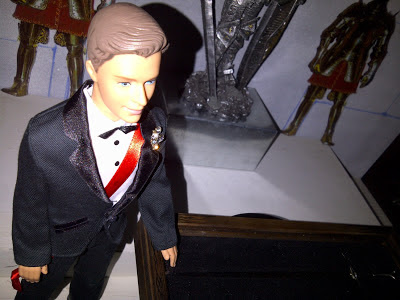A mysterious container was handed over to the Duke of Swann on his State Visit to Hanoveria. The Grand Duke of Hanoveria, the Duke of Swann's cousin, discovered the container in the basement of a warehouse building earmarked for restoration and refurbishment as modern apartments.
SNN Lifestyle Feature Reporter Kitty Spice joined the Duke of Swann at his private residence in Hanoveria to discuss the story surrounding the container and its history and of course to report to the international public on the great "reveal"of its contents.
Royalty and History are seemingly inextricably linked. Today we see that reality as it will manifest before our eyes. Schloss Schwanstein is the idyllic setting on this amazing spring morning for a modern fairy tale to be revealed.
Miss Kitty Spice introduces the days events.
The truck carrying the container prepares to enter the Duke's property.
The truck transporting the container arrived at Schloss Schwanstein a few minutes late. The Duke of Swann waited, visibly excited, alongside the Head Curator of his International Art and Historic Artifact Collections, Marelize Von Engelbrecht.
There was an audible gasp even from the media crew as the contents of the container was brought out into the light of day for the first time in half a century.
The container revealed a 1909 Rolls Royce Silver Ghost. To put it in the Duke of Swann's own words, ..."an absolute childhood fantasy made real..."
A close-up of the antique car.
The Rolls Royce is an exceptional historic find purely as it is an extremely rare vehicle. It is in extremely good shape and the Duke's mechanics assure him that it will be in perfect working order within a week. The car was revealed by paperwork found in its cubbyhole, to have been made for the current Duke of Swann's grandfather. He took ownership of it before the great war and it was caught on the Europan mainland as the war broke out. More historic research will have to be done to find more specific details but Rolls Royce official records concur that this model was indeed made for the said Duke of Swann in 1909.
The car was not the only contents of the container. A sealed solid oak trunk was also found inside and it was agreed to open that inside the house.
Searching the Duke of Swann's archives quickly revealed old photos of the car his grandfather ordered and also his intent to drive it on a private tour of Europa. The car and the initial stages of the tour was realized but cut short by the Great War.
An archive photo, taken at the Rolls Royce showroom in Fulco De'Este where the Duke of Swann took delivery of his new car.
The current Duke of Swann's Grandfather arrives at a Ruskian military parade in his honour in his Rolls Royce. This photo was taken just before the outbreak of the Great War and it currently hangs in Schloss Schwanstein where he died after being killed in the war leaving his baby boy and wife behind and the Principality being ruled by a Regency.
This spectacular photo shows the historic car and its contemporary owner. The Duke of Swann has announced that he will have the car fully restored and intends to take a tour of Europa in honour of his grandfather. He then intends to have it on permanent display at Sorgenfrei Castle as part of the Crown Prince Imperial's Museum of History but to also make it available as a wedding car for Royalty and Nobility making use of Sorgenfrei as their wedding venue.
We leave the Rolls Royce in its new temporary home in the garage at Schloss Schwanstein and we move on to the next reveal.
The room chosen for the opening of the chest was the Duke of Swann's private lounge.
Here His Royal Highness shows us the framed historic photo of his young grandfather and the Rolls Royce. The picture ironically hangs in the same room where the contents of the chest will be revealed.
Miss Kitty Spice makes the necessary commentary on camera as the Duke, with the help of his curator and butler prepare to open the box.
The ancient box is made of solid oak and weighs at least 200kg.
Again a shocked gasp was expressed by everybody in the room when the dazzling contents saw the light for the first time in over 70 years. The long thought lost Crown Jewels of Ruskiana was covered by as yet many unidentified other pieces of spectacular historic jewels. In this photo the Imperial Crown, an Iconic Cross in red pearls and some tiaras are clearly visible.
The Duke of Swann is seen here holding the Empress Consort of Ruskiana's Crown.
Historians, archivists and perhaps even lawyers will now have the job of uncovering the story behind the forgotten Royal shipment and in uniting the rightful owners with their property.
It is clear that the chaos surrounding the outbreak of the Great War halted the process of shipment and also lead to the container being "forgotten" in the Hanoverian warehouse. The Duke of Swann's grandfather obviously also died before he could reveal anything about his container and it's secret contents. It may be safely assumed that a clandestine plan was underway to save the jewels from the possible destruction the war could wreak on them.
A full detailed report of the contents of the chest will be featured on the blog in the next few weeks on a Tiaras and Trinkets on Tuesday Post. Some pieces will inevitably have undisputed ownership and be returned but controversy will abound and some lesser known pieces might end up on the auction block. Please keep your eyes peeled for the full story as it is revealed.





















































